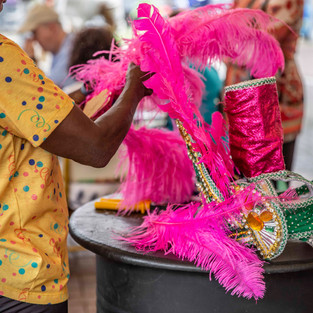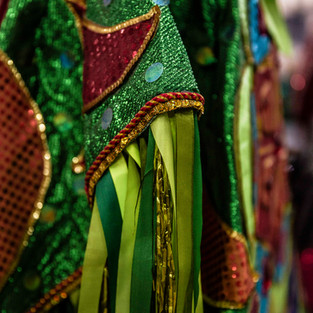Our First Taste of Carnaval - Cidade do Samba (Samba City)
- Dawnelle Salant
- May 6, 2020
- 4 min read
Updated: May 6, 2020
Antarctica and Carnaval in Rio were the two things on my bucket list that had to be arranged when I got my sabbatical. Both can only be done at certain times of the year, and teaching does not lend itself to travel outside of school holidays. Carnaval is still a few weeks away, but today we’re on our way to Cidade do Samba (Samba City) to do a tour of the Carnaval Factory where one of the major Samba schools is preparing for the parade. Carnaval is the world’s biggest party for sure - but it’s more than that. The parades, which take place in the Sambodrome, are something that I have always wanted to see and to be able to go behind the scenes is incredible. This is also something that can be done year round as preparation for these performances takes pretty much the entire year.
We enter the huge warehouse and immediately I see a giant float to my right. It’s fronted by a gigantic pink peacock and I marvel at the size of it. Our guide tells us that the floats are usually about 20m high, 30 meters wide and 50 feet long. It’s a wonder they fit in the building. The bottom floor is home to several floats, but we aren’t allowed to take photos here. They don’t want the other schools to know what they are planning.
There is so much history to Carnaval, and I’m fascinated by what our guide tells us. Samba originated in Rio in the early 1900’s, with black slaves and is now a major Brazilian icon. However, the parades are about storytelling. Samba was a way for the uneducated to tell stories, and each float in each school’s parade is a chapter within that story. The schools are judged on their plot or theme, along with harmony, percussion and many other aspects of their performance. We learn that each school has two flag bearers that carry an oversized flag for the entire show. There is so much more to these parades than just the flashy costumes, beautiful people and magnificent floats. Each Samba School represents an area of the city.
We walk up to the third floor, which weaves around openings that allow the floats to pop up through. The workers are seeing costumes and again, we aren’t allowed to take photos of anything for this year’s parade. We do get to take photos of previous years’ costumes, and I snap away at the feather, glitter and sequin covered masterpieces. I am fascinated to learn that everyone who works here gets paid, with the money coming from sponsors. Getting ready for the parade is a year long process - right after Carnaval, they start planning next year’s parade. I can see why - the story, the floats, the costumes, the dancing, the singing….. I don’t know how they do it!
We get to watch a video about the parades, and my heart thumps just watching it on tv. I can’t believe that in a few weeks I will get to realize my dream of seeing this live. If seeing it on tv gives me goosebumps, I can’t imagine what parade night will bring. Someone asks our guide if she dances in the parade, but she tells us that although she is on the floats, she is not in the spotlight as she can’t afford the 15,000 real (Brazilian currency) costume. Gulp. That’s about $5000 Canadian. She explains that after Carnaval everything is recycled. The hand made costumes are taken apart by hand and if the material can’t be used again, they find another use for it, like stuffing. Carnaval is not cheap, and they do everything they can to save money and use what they already have.
Afterwards, we get to dress up in old parade costumes and I am blown away by how heavy they are. My white dress is made of thick material and the feathered headpiece feels like it weighs a ton and the hard helmet digs into my forehead. People sing and dance in these in the humid heat of Carnaval, and I’m sweating just standing in the air conditioned room.
A beautiful girl comes in to Samba for us and they way she moves her body astounds me. She has such control over her feet, her hips- her entire body - as she bounces to the rhythm of the song. We get a small lesson and although they are basic moves, I feel like I understand Samba a lot more than Tango. It’s energetic and fun.
On the way out, we learn that Grande Rio, the school factory we are visiting right now, will be performing on the night we attend the parades. I tell our guide this and she brings us back in to have another quick peek at the floats so we will recognize them in the Sambodrome. I ask her when the last time her school won the parade was and she looks a little sad. Grande Rio has yet to win a parade, but maybe this will be their year. That would be something to see! (Stay tuned to see how Rio Grande places in the parade this year!)
















































Comments